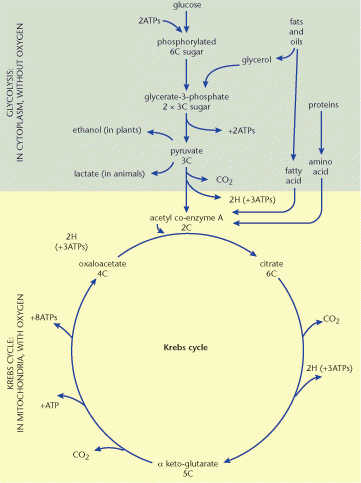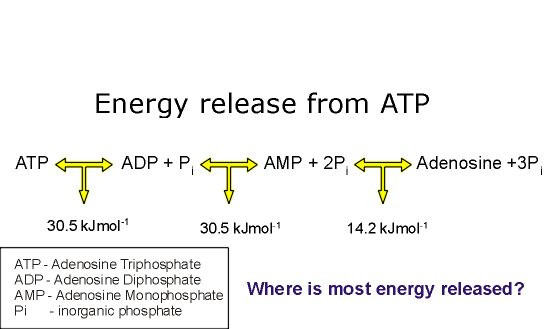Adenosine triphosphate (ATP)
A glucose molecule has a high energy content. If all the energy was released at once then there would be severe temperature problems in a cell. It is important that energy liberation is in small bursts. This is achieved by using adenosine triphosphate (ATP) molecules. Substrates such as glucose are broken down in enzyme-catalysed stages to produce a number of ATP molecules.
ATP synthase
ADP (adenosine diphosphate) + P (phosphate) = ATP (adenosine triphosphate)
Remember that in photosynthesis ATP molecules are both synthesised then used to supply energy in the light-independent stage!
ATP is a molecule which is needed in all energy-requiring processes.
The ATP needs to be broken down to liberate its energy. This is done by an enzyme, ATPase.
ATPase
ATP (adenosine triphosphate) = ADP (adenosine diphosphate) + P (phosphate) + energy
ATPase is a hydrolysing enzyme so that a water molecule is needed, but this is not normally shown in the equation.
ATP is a phosphorylated nucleotide. Recall DNA structure which consists of nucleotides. Each nucleotide consists of an organic base, ribose sugar and phosphate group. ATP is a nucleotide with two extra phosphate groups! This is the reason for the term ‘phosphorylated nucleotide’.
adenine –––––– ribose –––––– phosphate –––––– phosphate –––––– phosphate
The hydrolysis of the terminal phosphate group liberates the energy. ATP is the energy currency of an organism.
Uses of ATP
- muscle contraction
- active transport
- synthesis of macromolecules
- stimulates the breakdown of substrates to make even more ATP for other uses.
The biochemistry of respiration
Respiration is vital to the activities of every living cell. The flow diagram opposite shows stages in the breakdown of glucose and other substrates to produce a supply of ATP.

The flow diagram shows only the main stages of each process.
The two molecules of ATP are needed to begin the process. Each stage is catalysed by an enzyme, e.g. a decarboxylase removes CO2 from a molecule.
ALERT! After the production of glycerate-3- phosphate the number of ATP molecules can be doubled. Each molecule of glycerate-3-phosphate gives rise to 20 molecules of ATP. Do not forget to take away the two ATPs at the start. So the total number of ATPs from one molecule of glucose is 38 (40 – 2). Count the ATPs in the diagram. Account for each ATP in the 38 total. This is a typical examination task!
The phosphate groups can be removed one at a time, releasing energy with each change in structure

Actually, the ATP is hydrolysed to ADP:
ATP + H2O → ADP + H3PO4
ATP is a small, water-soluble molecule (a nucleotide). This enables ATP to travel freely within the cell.
These reactions are easily reversible but some energy is lost as thermal energy because:
- Energy conversions are not 100% efficient
- Energy available from the steps of respiration may not exactly match the energy needed to build up ATP
- Energy needs may not match exactly the energy released by the hydrolysis of ATP
ATP is energy currency not energy storage (glucose, glycogen, starch, fats)
- ATP is constantly and rapidly recycled
- There is only about 5g of ATP in the entire human body
- Up to 40kg equivalent of ATP is used in 24 hours
- In hard exercise 500g of ATP is broken down per minute to fulfill energy requirements
- This means that each molecule of ATP is built up and broken down up to 100 times per minute
Creatine Phosphate and Muscle Contraction
The production of hydrogen atoms during the process can be monitored using DCPIP (dichlorophenol indophenol). It is a hydrogen acceptor and becomes colourless when fully reduced.
The energy for muscle contraction comes from the hydrolysis of ATP:
ATP → ADP+Pi
But the high energy demand of muscle requires a backup system with creatine phosphate (PCr):
PCr → Cr + Pi
There is three times as much PCr as ATP in resting muscle. Creatine Phosphate replenishes ATP by giving up a phosphate group to ADP to rebuild ATP.
This allows more energy to be released more quickly, adequate for a short burst of activity. The PCr must be replenished using energy supplied via ATP from respiration.
